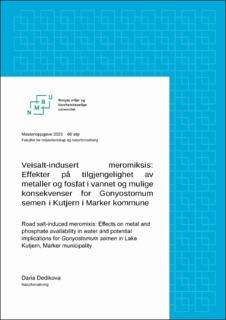| dc.contributor.advisor | Thomas Rohrlack | |
| dc.contributor.advisor | Gunnhild Riise | |
| dc.contributor.author | Dedikova, Daria | |
| dc.date.accessioned | 2023-07-19T16:28:22Z | |
| dc.date.available | 2023-07-19T16:28:22Z | |
| dc.date.issued | 2023 | |
| dc.identifier | no.nmbu:wiseflow:6839647:54592831 | |
| dc.identifier.uri | https://hdl.handle.net/11250/3080284 | |
| dc.description.abstract | Masteroppgaven omhandler undersøkelser av effektene av veisalt på Kutjern, en innsjø i regionen, både kjemisk og økologisk. Veisaltet fører til meromiksis i innsjøen, som forårsaker opphopning av tungmetaller, som bly, krom, aluminium, nikkel og mangan, i bunnsjiktet av innsjøen. Konsentrasjonene av disse stoffene ble målt gjennom hele studieperioden, og det ble funnet at konsentrasjonen av bly var lik tilstandsklasse 3 (moderat), mens konsentrasjonene av sink, nikkel og krom var tilstandsklasse 2. Resultatene viser at veisaltet har forårsaket meromiksis i innsjøen, som hindrer vår- og høstmikser, undertrykker oksygentilførselen til bunnvannet og akkumulering av næringsstoffer i innsjøen. Det er mest sannsynlig at forhøyede konsentrasjoner av bly ikke har hatt noen påvirkning på veksten til G. semen. Dette kan delvis tilskrives bindingen av bly i partikler, så vel som de lave konsentrasjonene av bly og G. semens toleranse mot dette metallet. G. semens toleranse mot bly kan være del av ytterligere undersøkelser.
I tillegg til tungmetaller har fosfat og fosfor også vært et fokusområde i undersøkelsene av Kutjern. Fosfat er et viktig næringsstoff for alger og andre vannplanter, men høye konsentrasjoner av fosfat kan føre til overvekst av alger og redusert vannkvalitet. Resultatene viser at det var høye konsentrasjoner av fosfat i innsjøen, spesielt i overflatesjiktet. | |
| dc.description.abstract | The master's thesis investigates the effects of road salt on Kutjern, a lake in the region, both chemically and ecologically. The road salt leads to meromixis in the lake, causing the accumulation of heavy metals such as lead, chromium, aluminum, nickel, and manganese in the lake's bottom layer. The concentrations of these substances were measured throughout the study period, and it was found that the concentration of lead was in condition class 3 (moderate), while the concentrations of zinc, nickel, and chromium were in condition class 2. The results show that road salt has caused meromixis in the lake, preventing spring and fall mixing, suppressing the oxygen supply to the bottom water, and accumulating nutrients in the lake. Elevated concentrations of lead are unlikely to have had any effect on the growth of G. semen. This may be partially due to the binding of lead in particles, as well as the low concentrations of lead and G. semen's tolerance to this metal. G. semen's tolerance to lead may be part of further investigations.
In addition to heavy metals, phosphate and phosphorus have also been a focus area in investigations of Kutjern. Phosphate is an important nutrient for algae and other aquatic plants, but high concentrations of phosphate can lead to overgrowth of algae and reduced water quality. The results show that there were high concentrations of phosphate in the lake, especially in the surface layer. | |
| dc.language | nob | |
| dc.publisher | Norwegian University of Life Sciences | |
| dc.title | Veisalt indusert meromiksis: Effekter på tilgjengelighet av metaller og fosfat i vannet og mulige konsekvenser for Gonyostomum semen i Kutjern i Marker kommune | |
| dc.type | Master thesis | |
